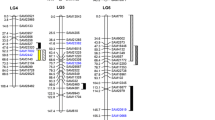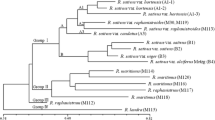Abstract
To analyze quantitative trait loci (QTLs) affecting flooding tolerance and other physiological and morphological traits in Echinochloa crus-galli, a restriction fragment length polymorphism (RFLP) map was constructed using 55 plants of the F2 population (E. crus-galli var. praticola × E. crus-galli var. formosensis). One hundred forty-one loci formed 41 linkage groups. The total map size was 1,468 cM and the average size of linkage groups was 35.8 cM. The average distance between markers was 14.7 cM and the range was 0–37.2 cM. Early comparisons to the genetic maps of other taxa suggest appreciable synteny with buffelgrass (Pennisetum spp.) and sorghum (Sorghum spp.). One hundred ninty-one F2 plants were used to analyze QTLs of flooding tolerance, plant morphology, heading date, number of leaves, and plant height. For flooding tolerance, two QTLs were detected and one was mapped on linkage group 24. Other traits, including plant morphology, heading date, number of leaves, and plant height were highly correlated. Three genomic regions accounted for most of the mapped QTLs, each explaining 2–4 of the significant marker-trait associations. The high observed correlation between the traits appears to result from QTLs with a large contribution to the phenotypic variance at the same or nearby locations.



Similar content being viewed by others
References
Bailey PC, McKibbin RS, Lenton JR, Holdsworth MJ, Flintham JE, Gale MD (1999) Genetic map locations for orthologous Vp1 genes in wheat and rice. Theor Appl Genet 98:281–284
Bowers JE, Abbey C, Anderson S, Chang C, Draye X, Lattu AH, Jessup R, Lemke C, Lennington J, Li Z, Lin Y, Liu S, Luo L, Marler BS, Ming R, Mitchell SE, Qiang D, Reischmann K, Schulze SR, Skinner DN, Wang Y, Kresovich S, Schertz KF, Paterson AH (2003) A high-density genetic recombination map of sequence-tagged sites for Sorghum, as a framework for comparative structural and evolutionary genomics of tropical grains and grasses. Genetics (in press)
Chen M, Sanmiguel PD, Oliveira AC, Woo SS, Zhang H, Wing RA, Bennetzen JL (1997) Microcolinearity in sh2-homologous regions of the maize, rice, and sorghum genomes. Proc Natl Acad Sci USA 94:3431–3435
Chittenden, LM, Schertz KF, Lin YR, Wing RA, Paterson AH (1994) A detailed RFLP map of Sorghum bicolor x S. propinquum, suitable for high-density mapping, suggests ancestral duplication of Sorghum chromosomes or chromosomal segments. Theor Appl Genet 87:925–933
Fox TC, Mujer CV, Andrews DL, Williams AS, Cobb BG, Kennedy RA, Rumpho ME (1995) Identification and gene expression of anaerobically induced enolase in Echinochloa phyllopogon and Echinochloa crus-pavonis. Plant Physiol 109:433–443
Fukao T, Murayama H, Onoue T, Yamasue Y, Inoue M (1998) The inheritance of alcohol dehydrogenase isozymes in seeds of hexaploid Echinochloa crus-galli Beauv. Genes Genet Syst 73:159–162
Fukao T, Kennedy RA, Yamasue Y, Rumpho ME (2003) Genetic and biochemical analysis of anaerobically-induced enzymes during seed germination of Echinochloa crus-galli varieties tolerant and intolerant of anoxia. J Exp Bot 54:1421–1429
Gale MD, Devos KM (1998) Comparative genetics in the grasses. Proc Natl Acad Sci USA 95:1971–1974
Holm LG, Plucknett DL, Pancho JV, Herberger JP (1977) The world’s worst weeds, The University Press, Honolulu, pp 41–46
Jessup R, Burson BL, Burow G, Wang Y-W, Chang C, Li Z, Paterson AH, Hussey MA (2002) Disomic inheritance, suppressed recombination, and allelic interaction govern apospory in buffelgrass, as revealed by genome mapping. Crop Sci 42:1688–1694
Jessup R, Burson BL, Burow G, Wang YW, Chang C, Li Z, Paterson AH, Hussey MA (2003) Genome mapping of buffelgrass (Pennisetum ciliare (L.) Link syn. Cenchrus ciliaris L.) reveals segmental allotetraploidy, suppressed recombination, and segregation distortion. Theor Appl Genet (in press)
Jiang C, Wright RJ, Woo SS, DelMonte TA, Paterson AH (2000) QTL analysis of leaf morphology in tetraploid Gossypium (cotton). Theor Appl Genet 100:409–418
Kamolsukyunyong W, Ruanjaichon V, Siangliw M, Kawasaki S, Sasaki T, Vanavichit A, Tragoonrung S (2001) Mapping of quantitative locus related to submergence tolerance in rice with aid of chromosome walking. DNA Res 8:163–171
Keller B, Feuillet C (2000) Colinearity and gene density in grass genomes. Trends Plant Sci 5:246–251
Lander ES, Botstein D (1989) Mapping Mendelian factors underlying quantitative traits using RFLP linkage maps. Genetics 121:185–199
Lin YR, Schertz KF, Paterson AH (1995) Comparative mapping of QTLs affecting plant height and flowering time in the Poaceae, in reference to an interspecific Sorghum population. Genetics 141:391–411
Manly, KF, Cudmore, Jr, RH, Meer, JM (2001) Map Manager QTX, cross-platform software for genetic mapping. Mamm Genome 12:930–932
Nandi S, Subudhi PK, Senadhira D, Manigbas NL, Sen-Mandi S, Huang N (1997) Mapping QTLs for submergence tolerance in rice by AFLP analysis and selective genotyping. Mol Gen Genet 255:1–8
Nelson JC (1997) QGENE: software for marker-based genomic analysis and breeding. Mol Breed 3:239–245
O’Donoughue LS, Kianian SF, Rayapati PJ, Penner GA, Sorrells ME, Tanksley SD, Phillips RL, Rines HW, Lee M, Fedak G, Molnar SJ, Hoffman D, Salas CA, We B, Autrique E, Van Deynze A (1995) A molecular linkage map of cultivated oat. Genome 38:368–380
Paterson AH, Damon S, Hewitt JD, Zamir D, Rabinowitch HD, Lincoln SE, Lander ES, Tanksley SD (1991) Mendelian factors underlying quantitative traits in tomato: comparison across species, generations, and environments. Genetics 127:181–197
Paterson AH, Lin YR, Li Z, Schertz KF, Doebley JF, Pinson SRM, Liu SC, Stansel JW, Irvine JE (1995) Convergent domestication of cereal crops by independent mutations at corresponding genetic loci. Science 269:1714–1718
Paterson AH, Bowers JE, Burow MD, Draye X, Elsik CG, Jiang CX, Katsar CS, Lan TH, Lan YR, Ming R and Wright RJ (2000) Comparative genomics of plant chromosomes. Plant Cell 12:1523–1539
Sarma RN, Gill BS, Sasaki T, Galiba G, Sutka J, Laurie DA, Snape JW (1998) Comparative mapping of the wheat chromosome 5A Vrn-A1 region with rice and its relationship to QTL for flowering time. Theor Appl Genet 97:103–109
Sripongpangkul K, Posa GBT, Senadhira DW, Brar D, Huang N, Khush GS, Li ZK (2000) Genes/QTLs affecting flood tolerance in rice. Theor Appl Genet 101:1074–1081
Tikhonov AP, SanMiguel PJ, Nakajima Y, Gorenstein NM, Bennetzen JL, Avramova Z (1999) Colinearity and its exceptions in orthologous adh regions of maize and sorghum. Proc Natl Acad Sci USA 96:7409–7414
Watson L, Dallwitz MJ (1992) The grass genera of the world, revised edn. CAB International, Wallingford, pp 51–61
Xu K, Mackill DJ (1996) A major locus for submergence tolerance mapped on rice chromosome 9. Mol Breed 2:219–224
Yabuno T (1966) Biosystematic study of the genus Echinochloa. Jpn J Bot 19:277–323
Yamasue Y (2001) Strategy of Echinochloa oryzicola Vasing. in flooded rice. Weed Biol Manage 1:28–36
Yamasue Y, Tanisaka T, Kusanagi T (1990) Alcohol dehydrogenase zymogram, its inheritance and anaerobic germinability of seeds of Echinochloa weeds. Jpn J Breed 40:53–61
Acknowledgements
This work was supported by the University of Maine Agricultural and Forest Experiment Station (Project No. ME08756-01, External Publication No. 2639, M.E.R.); National Science Foundation (98-72649 and 01-15903, A.H.P.), Texas Agricultural Experiment Station (TEX08346, M.E.R.), Texas Higher Education Coordinating Board (999902-157, M.A.H.), and a Sigma Xi Grant-in-Aid of Research (T.F.).
Author information
Authors and Affiliations
Corresponding author
Additional information
Communicated by D.J. Mackill
Rights and permissions
About this article
Cite this article
Fukao, T., Paterson, A.H., Hussey, M.A. et al. Construction of a comparative RFLP map of Echinochloa crus-galli toward QTL analysis of flooding tolerance. Theor Appl Genet 108, 993–1001 (2004). https://doi.org/10.1007/s00122-003-1530-7
Received:
Accepted:
Published:
Issue Date:
DOI: https://doi.org/10.1007/s00122-003-1530-7




